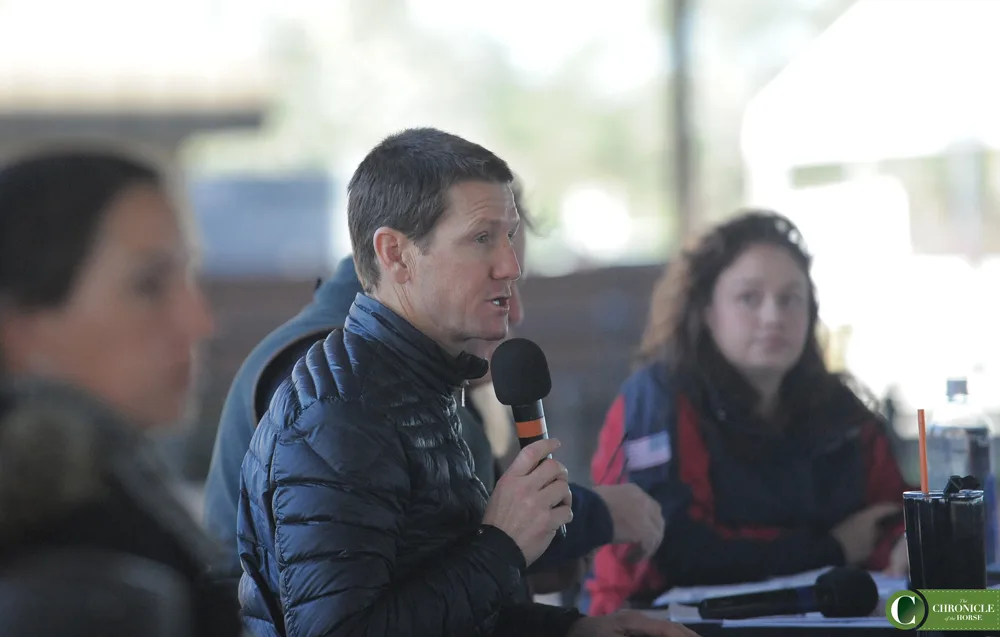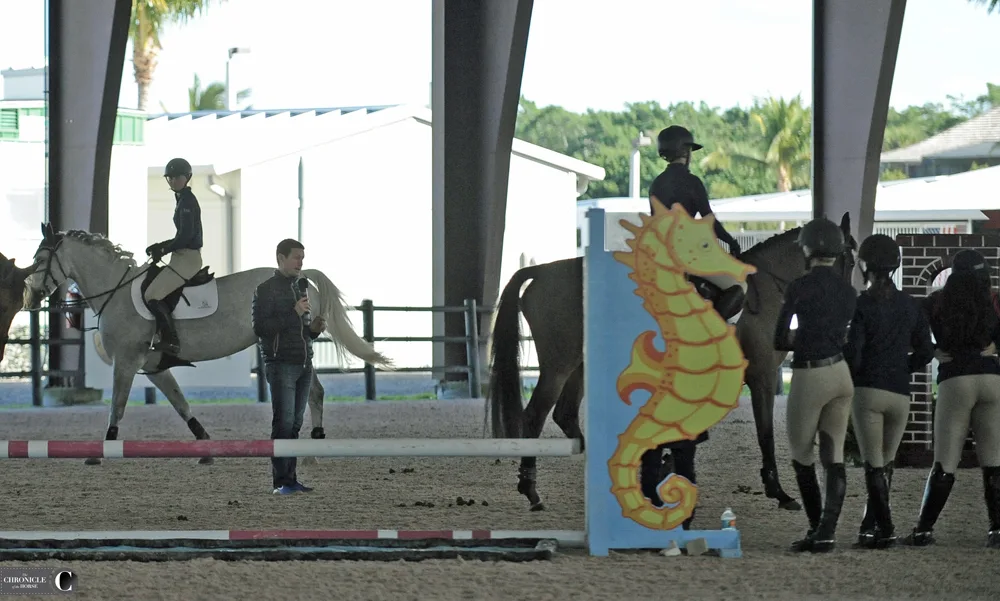Wellington, Fla.—Jan. 7
Perhaps the most informative and interesting part of McLain Ward’s lesson on Sunday at the George H. Morris Horsemastership Training Session came after the session was technically over and the live stream cameras turned off. Several riders really struggled in the mock Nations Cup competition the clinic hosts on the final day, particularly with stops and rider falls at the open water fence, so the world’s No. 2-ranked show jumping rider took an extra half hour after his session to give these students a master class in how to deal with a stop on course and how to properly ride a spooky fence.
“To be honest, when things don’t go perfectly there is probably more to be learned, I think,” Ward said. “These kids that had trouble with the water today learned a lot, because all these horses jumped the water in the end; it just needs to be addressed in the right way.
“The big thing is that not that we’re going to be perfect. It’s not a sport of perfection,” Ward continued. “It’s about having the tools to understand how to make things better.”
The mock Nations Cup consisted of two jumping rounds over an identical course with riders grouped into teams that accumulated faults from rails and stops. Early on in the course, riders were asked to jump a wall of blocks before rolling back on an oxer and then galloping directly to an open water with a rail over it. That’s where the majority of the problems popped up for roughly half the riders in the clinic—horses ran right by the water, slid into the base of it, and a couple swam through the rails and lost their rider on the back side (all riders were able to remount and finish the clinic).
In a competition setting, Ward said some of the riders made their first mistake before they even attempted the fence.
“When you trotted in the ring you never settled, you never took a second to calm yourself and your horse before you started,” Ward said to one rider. “You kind of showed him that water, but you just trotted right past it and didn’t really give him a look. Use your time—you have 45 seconds, so compose yourself and your horse before you start.”

McKayla Langmeier finishes up a pretty flawless round as McLain Ward commentates—Ward used Langmeier as an example of a rider others could watch and emulate. Photo by Ann Glavan.
After a horse would stop at the water, Ward would school students on the proper way to address a stop in the show ring.
“Take your time. You’re already not going to make the time allowed so there’s no point in rushing,” Ward said. “Set yourself up for a good long approach, and in the corner before you turn to the fence I’d give him a good smack with the whip and make sure he’s in front of my leg. Get him in front of your leg back there in the corner.”
Ward stopped to clarify the use of the whip in this exercise.
ADVERTISEMENT
“You’re not using your whip to cause the horse pain, you’re using the whip to let him know that it’s there and he has to stay in front of your leg,” Ward said.

Riders turned from this block wall (shown here being jumped by Kendra Duggleby) to an oxer before approaching the open water fence that gave many trouble. Photo by Ann Glavan.
Riders were allowed two attempts at the water during the mock Nations Cup, and a few had horses that would simply gallop right past the fence on multiple attempts, which Ward said was unacceptable.
“When they run out side to side you’re opening a door,” Ward said. “If I’m riding a horse or Beezie is riding a horse that stops at the water, I guarantee you he’s not going to go by it. He may stop, but he’ll be in front of it.”
After the mock Nations Cup is when Ward started teaching the riders who had stops and falls how he would address this issue at home. He started by building a new exercise—he made a very small vertical over a liverpool directly adjacent to the original problem water jump, and he built a crossrail over the water jump.
“This is how I would school the water with a horse I think is a little nervous about it. I give a very mild presentation of the water with a liverpool where the horse can’t get in trouble and gains confidence,” Ward explained. “Then you just move right next door to the water and the horse is usually over the water before they realize it wasn’t the liverpool.”
Ward also incorporated guide rails and people on the ground clucking from the wings to encourage the horses over, though he warned riders to only use help from the ground from knowledgeable people, as an unskilled person could do more harm than good.
Ward also had some riders carry a dressage whip instead of a short jumping bat.
“I like a dressage whip in this situation because a lot of times you don’t want to take your hand off the reins with one that’s really nervous at the water,” Ward said.
On the way up to the fence Ward told riders not to be pulling on their horses too much.
“I think some of you got in trouble the first time because you were doing these half halts and trying to do everything for him. Are you carrying the horse or is he carrying you?” Ward asked. “He’s carrying you, so you have to let the horse gallop along and only balance when you need it. You can’t just be pulling and kicking.
ADVERTISEMENT
“Very rarely do I come out of the ring winded, and that’s not because I’m fitter than other people,” Ward continued. “It’s because I let the horse do the work. I’m just a guy. I’m kind of just controlling a runaway missile—you have to let the horse go and make adjustments as you need. That first time around you were trying to ride every stride and do something different every stride. Instead, let him gallop along.”
Once the rider has locked on to the distance at the fence Ward instructed them to hunker down and prepare for lift-off.
“The last couple strides, close the lower leg, sit in the saddle and ride them up into your hand,” Ward said.
Ward also cautioned riders to be disciplined in their own body position when addressing a spooky fence.
“You don’t need to worry about going forward in this exercise—stay behind the horse. If anything sit down and get left,” Ward said.
Half the problem with the particular fence riders in the clinic were having issues with is its foreignness in the modern competition life of a show jumping rider.
“You know these natural fences, so few people have experience with this anymore, starting with my generation and moving on to yours—everyone has so little experience with them they try to ride it like it’s just a crossrail,” Ward said. “You have to stay back and behind the horse and keep their head up. You have to be defensive, and it’s regulated defensive riding—you change as your horse changes—but you’re defensive.”
Last but not least, Ward offered riders and auditors alike some words of encouragement at the end of his extra session.
“You have to walk away from this experience knowing you were all able to conquer this water. It didn’t beat you,” Ward said. “Take these skills about how to deal with a problem like this and apply it to your training and then your competition riding.”
IMPORTANT LINKS: What You Need To Know | All the COTH coverage | Live Streaming

















